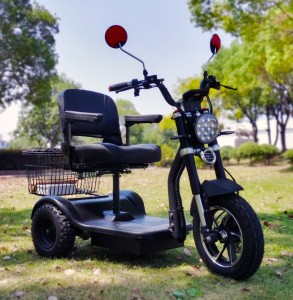Production Process and Quality Control of Three-Wheeled Scooters for the Elderly
As an essential daily companion for seniors, the safety, stability, and comfort of three-wheeled scooters directly impact the health and well-being of their users. A qualified scooter is more than a simple assembly of parts; it is the product of meticulous craftsmanship and quality control throughout the entire design, production, and testing process. This article will delve into the core production process of three-wheeled scooters for the elderly, revealing the quality control system from raw materials to finished product, allowing consumers to understand the technical secrets behind “safe travel.”
I. Production Process: Meticulous Craftsmanship from Components to Complete Vehicle
The production of three-wheeled scooters for the elderly involves a multidisciplinary process that balances mechanical structural stability, electrical system safety, and ergonomic comfort. The precision of each process impacts the quality of the final product.
(I) Core Component Production: Basic Materials Determine Safety
Frame Welding Process
As the “skeleton” of a scooter, the frame bears the core functions of bearing the vehicle’s weight and absorbing road impact. Its production process directly determines the vehicle’s resistance to deformation. High-quality mobility scooters are often made from Q235 low-carbon steel pipes. These are first precisely cut using a CNC cutting machine according to the design drawings, with an error tolerance of ±0.5mm. The bending process then uses a hydraulic press brake to shape the pipe at multiple angles, ensuring the frame’s curvature conforms to the human body’s sitting posture. Welding is performed using carbon dioxide (CO₂) shielded welding, with weld seam widths uniformly controlled at 8-12mm. Post-weld testing is performed to eliminate hidden defects such as porosity and cracks. Finally, the entire frame undergoes sandblasting to remove rust and electrostatic spraying, resulting in a 60μm-thick anti-corrosion coating that resists corrosion from outdoor moisture, acidic and alkaline environments, extending the frame’s service life.
Powertrain Assembly: A Balance of Efficiency and Safety
The powertrain consists of three core components: the motor, battery, and controller. Its assembly process directly impacts the scooter’s range and operational safety. The motor uses a permanent magnet brushless DC motor. During assembly, the gap between the rotor and stator must be kept within 0.2-0.3mm to minimize operating losses. The battery wiring utilizes cold-pressed terminal crimping and heat-shrink tubing for sealing to prevent loosening and short-circuiting risks. Flame-retardant foam is also used within the battery compartment to enhance fire resistance. The controller, serving as the “brain,” undergoes three power-on tests to ensure that response delays for acceleration, braking, and reverse commands do not exceed 0.1 seconds. It also automatically cuts power to protect the circuitry in the event of voltage fluctuations. Body and Seat Molding: Balancing Comfort and Durability
The body shell is primarily injection-molded from ABS engineering plastic with a mold precision of 0.02mm, ensuring a smooth, burr-free surface. It also passes high-temperature aging testing (70°C for 100 hours) to prevent cracking after sun exposure. The seats are constructed from high-resilience polyurethane foam with a density of ≥35kg/m³ and covered with waterproof and wear-resistant leather. Double-stitch overlocking is used for sewing, with a stitch length of 3-4mm, ensuring both strength and aesthetics. The seats are secured to the frame with stainless steel bolts and locknuts, tightened to a torque of 15N·m to prevent loosening after prolonged use.
(II) Vehicle Assembly: The “Last Mile” of Precision Matching
Vehicle assembly must be carried out in an orderly manner, following the principle of “interior first, exterior second, electrical first, engine second,” to ensure coordinated operation of all systems. First, the electrical system wiring is completed. The wiring harness is protected by corrugated tubing, with the spacing between fixing points no more than 30cm to prevent friction with moving parts. The suspension system is then installed, and the shock absorber preload is adjusted to 20-25mm to ensure driving stability. The wheels are then assembled, and the fit between the hub and tire is tested for airtightness. After inflation, the pressure is maintained for 24 hours to ensure no leaks. Finally, the body shell and accessory components (such as mirrors, turn signals, and storage compartments) are installed. All connections are re-checked with a torque wrench, ensuring that the torque deviation at key points (such as frame connections) does not exceed ±1N·m. After final assembly, the vehicle undergoes a preliminary power-on test to ensure that basic functions such as lights, horns, and brakes are functioning properly.
Second, Quality Control: Safety Through Full-Chain Closed-Loop Management
Quality control for elderly three-wheeled mobility scooters is implemented throughout the entire life cycle, from R&D to production, delivery, and after-sales service. Through multi-dimensional testing and standardized management, safety risks are minimized.
(I) Incoming Inspection of Raw Materials and Parts (IQC): Quality Control at the Source
All raw materials and parts must undergo triple inspections before entering the factory to prevent unqualified products from entering the production line.
Material Testing: Composition analysis of raw materials such as steel pipes and plastic particles is performed, and the carbon content of steel is measured using a spectrometer to ensure compliance with the Q235 standard. Battery capacity and cycle life testing are performed, requiring the capacity deviation to be no more than ±5% of the rated value at 20°C, and a capacity retention rate of ≥80% after 500 charge and discharge cycles.
Dimensional Inspection: A three-dimensional coordinate measuring machine is used to scan the dimensions of precision components such as vehicle frames and wheels, with an inspection accuracy of 0.001mm. The failure rate for critical dimensions must be kept below 0%.
Performance Testing: Motors must undergo a load test, operating continuously at rated power for two hours with a temperature rise not exceeding 60K. Brake components must undergo a braking performance test, with a braking distance of ≤1.5m under no-load conditions and ≤2.5m under full load. (II) Production Process Quality Control (IPQC): Real-time Monitoring to Eliminate Deviations
Eight key quality control points (KCPs) are set up during the production process, with dedicated inspectors assigned to each node. A “first-article inspection + patrol inspection + final-article inspection” model is implemented.
For every 10 vehicle frames produced during the welding process, one is sampled for compression testing. A load of 1.5 times the rated load (approximately 300 kg) is applied to the top of the frame for 10 minutes, ensuring deformation of the frame is ≤ 2 mm.
After assembly, the electrical system undergoes an insulation resistance test. A 500V megohmmeter is used to measure the insulation resistance between the circuit and the frame. A value of ≥100 MΩ is considered acceptable.
For every 20 vehicles in the final assembly process, a dynamic test is performed, simulating driving on a 15° slope to test power output and braking stability.
If a defective product is discovered, the traceability mechanism is immediately activated to identify the cause and suspend production until a corrective action plan is developed and verified to be effective.
(III) Finished Product Factory Inspection (FQC): Comprehensive Testing to Ensure Qualification
Finished products undergo 12 comprehensive inspections before leaving the factory. Only those that meet all standards can be labeled and shipped.
Appearance Inspection: Check the body for scratches, color variations, weld protrusions, smooth component installation, and clear and complete markings.
Performance Inspection: Conduct a 30-minute no-load running test, recording parameters such as motor speed, current, and noise level (≤65dB).
Safety Inspection: Includes braking performance, steering agility, headlight brightness (high beam ≥1500cd), and horn sound level (90-115dB).
Durability Inspection: Simulate daily use scenarios with a 100-kilometer continuous driving test. At the end of the test, check all components for looseness and leakage.
Environmental Adaptability Inspection: Conduct high and low temperature tests (-20°C to 60°C) and a rain test (100mm/h for 30 minutes) to ensure the vehicle operates normally in extreme environments. (IV) After-Sales Quality Traceability: Closed-Loop Problem Management
Each mobility scooter is equipped with a unique identification code, linking it to the entire lifecycle, including production batch, parts supplier, and inspection records. If a quality issue arises after sales, the identification code can be used to quickly trace the source and pinpoint the problem. If it’s a component defect, supplier rectification and recall procedures are immediately initiated; if it’s a production process deviation, the corresponding process operating procedures are optimized. A customer feedback database is also established to regularly analyze frequent issues and provide feedback to R&D and production, achieving a closed-loop quality cycle of “test-improve-enhance.”
Post time: Sep-22-2025



